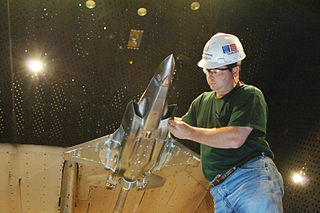
Austrian German, Austrian Standard German (ASG), Standard Austrian German, Austrian High German, or simply just Austrian, is the variety of Standard German written and spoken in Austria and South Tyrol. It has the highest sociolinguistic prestige locally, as it is the variation used in the media and for other formal situations. In less formal situations, Austrians use Bavarian and Alemannic dialects, which are traditionally spoken but rarely written in Austria. It has been standardized with the publishing of the Österreichisches Wörterbuch in 1951.

Wind tunnels are machines where an object is held stationary inside a tube, and air is blown around it to study the interaction between the object and the moving air. They are used to test the aerodynamic effects of aircraft, rockets, cars, and buildings. Different wind tunnels range in size from less than a foot across, to over 100 feet (30 m), and can have air that moves at speeds from a light breeze to hypersonic velocities.

The July Revolt of 1927 was a major riot starting on 15 July 1927 in the Austrian capital, Vienna. The revolt was sparked by the acquittal of three nationalist paramilitary members for the killing of two social democratic Republikanischer Schutzbund members and culminated with police forces firing into the outraged crowd and killing 89 protesters, and five policemen died. More than 600 protestors and around 600 policemen were injured.

The Belvedere is a historic building complex in Vienna, Austria, consisting of two Baroque palaces, the Orangery, and the Palace Stables. The buildings are set in a Baroque park landscape in the third district of the city, on the south-eastern edge of its centre. It houses the Belvedere museum. The grounds are set on a gentle gradient and include decorative tiered fountains and cascades, Baroque sculptures, and majestic wrought iron gates. The Baroque palace complex was built as a summer residence for Prince Eugene of Savoy.

The Arnold Engineering Development Complex (AEDC), Arnold Engineering Development Center before July 2012, is an Air Force Materiel Command facility under the control of the Air Force Test Center (AFTC). Named for General Henry "Hap" Arnold, the father of the U.S. Air Force, AEDC is the most advanced and largest complex of flight simulation test facilities in the world.

The McLaren Technology Centre is the headquarters of the McLaren Group and its subsidiaries, located on a 500,000 m2 (50 ha) site in Woking, Surrey, England. The complex consists of two buildings: the original McLaren Technology Centre, which acts as the main headquarters for the group, and the newer McLaren Production Centre, primarily used for manufacturing McLaren Automotive cars.

The University of Natural Resources and Life Sciences, Vienna, or simply BOKU, founded in 1872, is an education and research centre for renewable resources in Vienna, Austria. BOKU combines expertise in the fields of natural sciences, engineering and biotechnology as well as social and economic sciences. In research and teaching, it focuses on

Count Ernst Rüdiger von Starhemberg was military governor of Vienna from 1680, the city's defender during the Battle of Vienna in 1683, Imperial general during the Great Turkish War, and President of the Hofkriegsrat. By birth he was member of the House of Starhemberg.

Baron Theophil Edvard von Hansen was a Danish architect who later became an Austrian citizen. He became particularly well known for his buildings and structures in Athens and Vienna, and is considered an outstanding representative of Neoclassicism and Historicism.

Wien Westbahnhof is a major Austrian railway station, the original starting point of the West railway (Westbahn) and a former terminus of international rail services. In 2015, its role changed with the opening of Vienna's new main station and Westbahnhof is now mainly a commuter station and the terminus of private rail operator WESTbahn's intercity service from Salzburg. Locally, Wien Westbahnhof is served by S-Bahn line S50 and U-Bahn lines U3 and U6. Six tram lines converge on Europaplatz in front of the station, although none go into the city centre. There are also buses to the airport.

The Museum of Military History – Military History Institute in Vienna is the leading museum of the Austrian Armed Forces. It documents the history of Austrian military affairs through a wide range of exhibits comprising, above all, weapons, armours, tanks, aeroplanes, uniforms, flags, paintings, medals and badges of honour, photographs, battleship models, and documents. Although the museum is owned by the Federal Government, it is not affiliated with the Federal museums but is organised as a subordinate agency reporting directly to the Ministry of Defence and Sports.

The Vienna S-Bahn is a suburban commuter rail network in Vienna, Austria. As opposed to the city-run urban metro network, the Vienna U-Bahn, it extends beyond the borders of the city, is operated by the ÖBB, and consists of many branch lines. S-Bahn is short for Schnellbahn, which can be translated as "rapid railway".

The Chrysler World Headquarters and Technology Center (CTC) is the North American headquarters and main research and development facility for the automobile manufacturer Stellantis. The 504-acre (204 ha) complex is located next to Interstate 75 in Auburn Hills, Michigan, a northern suburb of Detroit. The complex has 5,400,000 square feet (500,000 m2) of usable space, placing it among the largest buildings in the world by floor space. Completed between 1993 and 1996 for the Chrysler Corporation, the building has followed the company as it changed hands several times since, serving as the North American headquarters for DaimlerChrysler, Fiat Chrysler Automobiles (FCA) and now Stellantis North America.

The Künstlerhaus in Vienna's 1st district has accommodated the Künstlerhaus Vereinigung since 1868. It is located in the Ringstrassenzone in between Akademiestraße, Bösendorferstraße and Musikvereinsplatz.
The history of the Jews in Vienna, Austria, goes back over eight hundred years. There is evidence of a Jewish presence in Vienna from the 12th century onwards.

Linz Hauptbahnhof or Linz Central Station is a railway station in Linz, the third largest city in Austria, and capital city of the federal state of Upper Austria. Opened in 1858, the station is the centrepiece of the Linz transport hub. It forms part of the Western Railway, and is also a terminus of the Pyhrn Railway, the Summerauer Railway, and the Linzer Lokalbahn (LILO). The station is owned by the Austrian Federal Railways (ÖBB); train services are operated by the ÖBB and the LILO. With 40,800 passengers daily in 2018/2019, it is the busiest station in Austria outside of Vienna, and the 7th-busiest overall.
The Federal Ministry of Defence of Austria is the ministry in charge of all matters relating to military affairs, especially the Austrian Armed Forces. It is Austria's ministry of defence. Its current minister is Klaudia Tanner.

Georg Decker was an Austro-Hungarian portrait artist.
HOLODECK architects is a Vienna, Austria based architectural studio. Established in 1998, it is a partnership of Marlies Breuss and Michael Ogertschnig.

The Army Cross for the Wars' of 1813–14,, also called the "Cannon Cross", was a military decoration of the Austrian Empire durig the Napoleonic Wars. It was created on 13 May 1814 by decree of Emperor Francis II of Austria. The decoration could be awarded to all soldiers who took part in German Wars of Liberation against Emperor Napoleon I.























